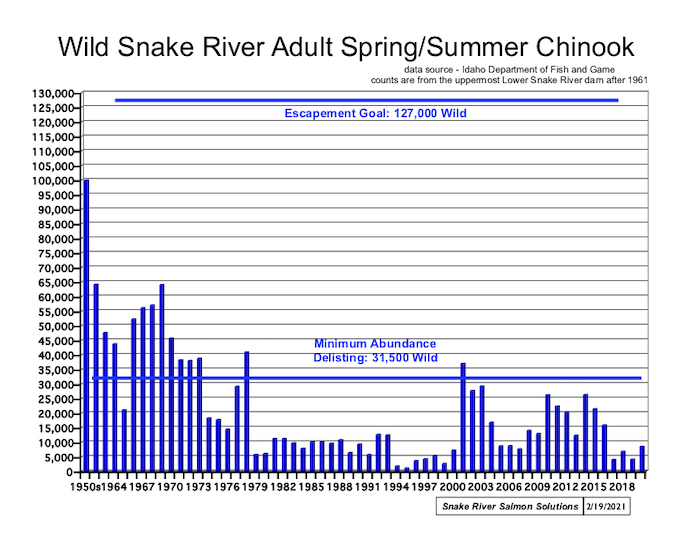forum
library
tutorial
contact

Facts About the
Lower Snake River Dams
by Jerry Freilich
Bend Bulletin, August 22, 2022
|
the film forum library tutorial contact |

|
Facts About the
by Jerry Freilich
|
Issues like barging, recreation and irrigation can be resolved in time.
But the fish have no more time.
 Dave Markham's piece on the Lower Snake River Dams (LSRD's) in The Bulletin in July was so far from reality it was hard to believe. As a PhD aquatic ecologist, I spent 13 years as Research Coordinator at Olympic National Park while we were removing the two Elwha River Dams. Yes, I know that dams are complicated. But let's keep to the facts.
Dave Markham's piece on the Lower Snake River Dams (LSRD's) in The Bulletin in July was so far from reality it was hard to believe. As a PhD aquatic ecologist, I spent 13 years as Research Coordinator at Olympic National Park while we were removing the two Elwha River Dams. Yes, I know that dams are complicated. But let's keep to the facts.
Markham said the LSRD's provided reliable carbon-free power and that breaching the dams would not benefit the salmon. He said that a National Oceanic Atmospheric Administration (NOAA) report was an "opinion paper" dependent on scientific input from "two anti-dam proponents." He wrote that, "Public power customers could expect rate increases of up to 65%," and that "senior citizens and those on fixed incomes should not have to endure blackouts nor choose between medicine, food, or paying their electric bills." Sounds grim, doesn't it? Luckily, nearly everything in his article was wrong. As New York Senator Moynihan famously said, "Everyone is entitled to his own opinion, but not his own facts."
The LSRD's do provide reliable power, but mostly in spring when it is least in demand. When demand for energy is high in summer and winter, the dams contribute little. And although they don't burn fossil fuel, the warm water reservoirs above them release large amounts of the greenhouse gas methane. So, in that sense they are definitely not "carbon free."
The power industry can drown anyone in statistics. But the bottom line is that hydropower is expensive, and its price will continue to rise. For example, three of the 24 dam turbines are already slated for replacement at a cost of more than $92 million. Solar and wind prices are already lower than hydro and will continue to fall. Today, renewables are beating practically every other type of power in the wholesale market. Much of the dams' generated power is sold elsewhere and reserve power to replace the dams' energy is already on hand several times over.
Even if the dams switched off tomorrow, no one would go dark.
What about costs? The Bonneville Power Administration (BPA) is supposed to provide reliable power at beneficial prices. But according to damsense.org did you know that in 2019 BPA had to borrow $429 million from the federal government to cover costs after spending over a billion on fish mitigation in a single year? The agency's financial statements show its current electricity rates will allow it to repay debts on time, but this includes raising rates, delaying maintenance, and continued borrowing.
BPA refinances debt by borrowing from other electricity vendors to repay its U.S. Treasury debt.
BPA is a confusing, quasi-government entity. As a business, it verges on bankruptcy. But as an appendage of the government, it has access to subsidies and bailouts coming from our tax dollars! This curious relationship creates baffling cover for people with vested interests. Recent Bonneville CEO Elliot Mainzer is shown in the film "Dammed to Extinction" stating that BPA's finances are simply unsustainable.
I was shocked that Markham referred to a NOAA Fisheries report as an "opinion paper." As a former government scientist, I know well the painful rigor of scientific peer review. Dozens of scientific reports over decades have clearly shown that if the LSRD's are not breached, the salmon are doomed. All of the Columbia Basin salmon populations are already on the Endangered Species List.
I could go on and list other fabrications in Markham's column. But my comments should give readers pause. Other issues like barging, recreation and irrigation can be resolved in time. But the fish have no more time. Their time has run out. Washington Gov. (Jay) Inslee and Sen. (Patty) Murray, D-Wash., are supposed to release their own plan for the dams soon. Our Sens. (Ron) Wyden and (Jeff) Merkley have inexplicably refused to take positions on this.
If the points in this letter make sense to you, let our senators hear from you!
learn more on topics covered in the film
see the video
read the script
learn the songs
discussion forum
